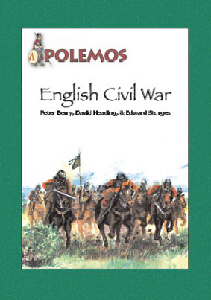|
|
|||||||||
 |
|
The Rules Directory only works if you help. Write a review. Get the review template here. |
|
TITLE: Polemos English Civil War (2005) AUTHOR: Peter Berry, David Heading & Edward Sturges PUBLISHER: Baccus 6mm – www.baccus6mm.com – baccus6@aol.com PUBLICATION DATE: April 2005 WEB SITE/SUPPORT FORUM: There is a Yahoo group that supports the entire family of Polemos rules sets. Or try the Baccus web site. PRICE £15.00 (2008) REVIEWED BY: Peter Berry – I am one of the authors and the publisher of the rules. PERIOD COVERED: English Civil War THE BOOK: Staple bound A4 booklet. 80 pages. Colour card cover with b/w interior. Card playsheet included. SCOPE: Aims to cover large actions of the period. Grand tactical may be a reasonable description. ARMY SIZE: PECW works on bases. The numbers of figures and size of bases depends on the individual. For example the ‘official’ 60mm x 30mm base can hold up to 36 6mm infantry and 18 cavalry. Larger sized figures on the same bases will have a smaller figure count. A small army may have 8-10 infantry bases and 12-16 cavalry. A medium army may have 16-20 infantry bases and 24-32 cavalry. A large army can have 24+ infantry and 40+ cavalry bases. BASE UNIT: An infantry base represents a ‘battalia’ of about 500 men. A cavalry base represents a squadron of about 125 men. A base of artillery represents 2 field artillery pieces. Infantry and cavalry operate in brigades consisting of multiple bases, and it is these that form the manoeuvre units for the game. GAME SCALES:
BASING SIZES:
TURN SEQUENCE:
The key to the system in the Tempo Bidding. Each general has a number of Tempo Points available to him with which to move and order his army. At the beginning of each turn, players can bid some of these TPS in order to become the Tempo Player, which allows him to move first and perform actions more cheaply than the Non-tempo player. Any TPs bid are deducted from the pool available to the General. GAME MECHANICS: D6 are used throughout. Combat is resolved by determining the difference in combat factors of opposing bases. No figure removal. Each base takes levels of ‘shaken’ up to a maximum of three at which point it routs. Shaken units are less effective in combat. Infantry base factors are derived from their pike to shot rato – these go from (All) Pike, Pike Heavy, Mixed, Shot Heavy and (All) shot. Cavalry base factors are derived from their tactical training – Gallopers and Trotters. TPs (See above) are used to move brigades and recover shaken levels. The non-Tempo players pay more for these actions than the Tempo player. Morale is conducted at the army level and a test is triggered by losses during a move. A failed test will affect the overall morale of the army reducing effectiveness and restricting the range of aggressive actions allowed to it. ARMY LISTS/SCENARIOS: Army lists are based on historical examples. Each section consist of the following:
Lists included are:
There is no points system. REVIEWER’S COMMENTS: I think these are the best ECW rules available. But there again I would say that… They are however, a serious attempt to relate the history and the research of the ECW to a wargame, rather than an exercise in rehashing out of date sources and ‘Gadzookery’ of the very worst kind. Armies are ponderous, you cannot attempt radical redeployments once the game in underway, musket ranges are short and artillery are ineffective. PLAYERS’ COMMENTS To leave your own comments or to read those of other gamers please click here. |
|
[Home] [15mm World] [Reviews Home] [How To] [Beginners Guide] [Gamer's World] [Spanner & The Yank] [Points of View] [The Annex] [Links] [Say Howdy] [Corporate Schill] [Rules Directory] |
 |
